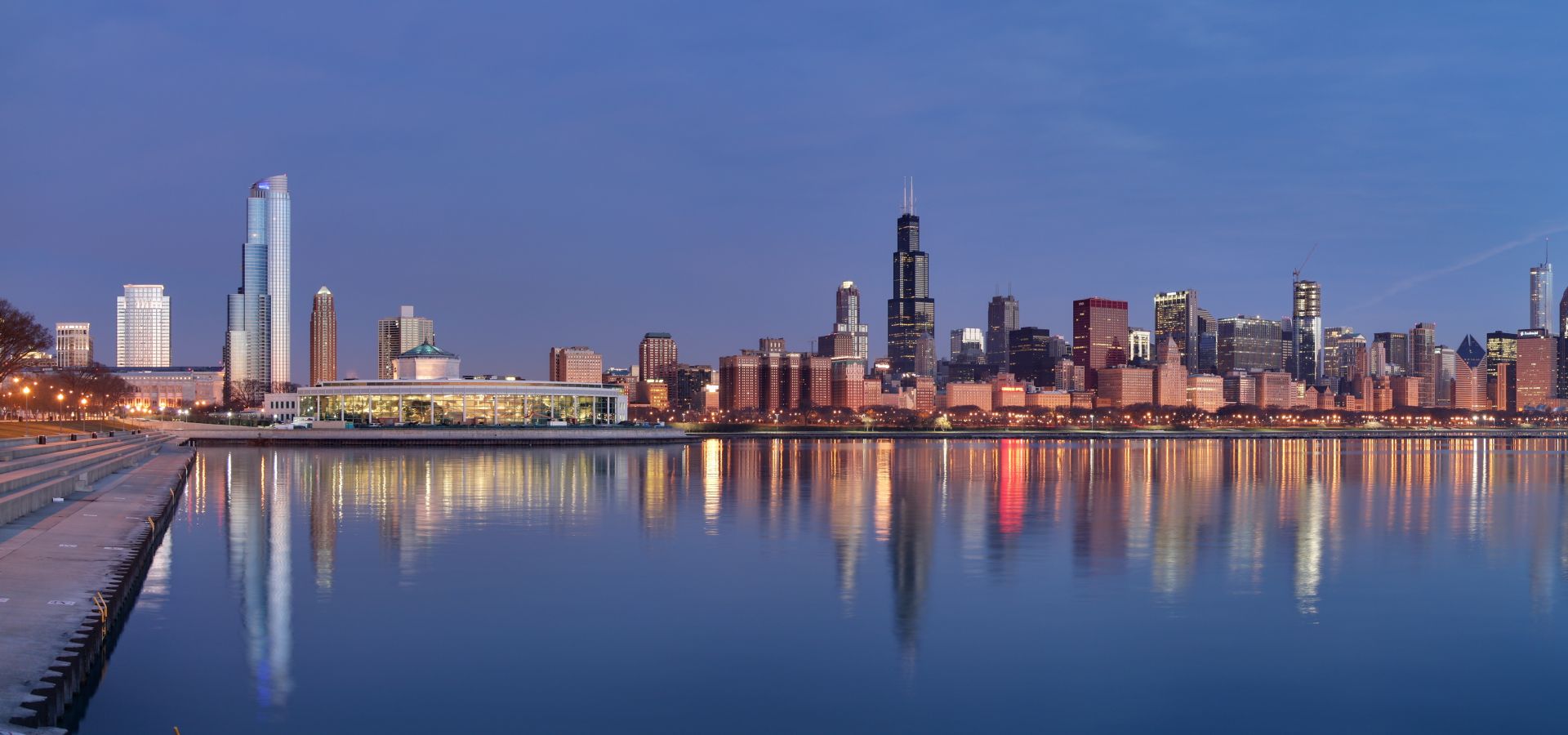In the US, where climate denialism is rampant, and the President is working against the energy transition, can cities take a leadership role in reducing emissions? Certainly, and they’re doing it. Silvia Weko takes a look at the American cities that want to reduce the consumption of fossil fuels, and improve quality of life while they’re at it.

Cities like Chicago have to push the energy transition without help from the federal government (Photo by Daniel Schwen, edited, CC BY-SA 4.0)
Globally, cities account for 70 percent of greenhouse gas emissions – so their policy can determine whether we (quite literally) sink or swim. Can US cities reduce emissions enough to keep the country anywhere near its Paris goals? (A reminder: the US target was 26% below 2005 levels by 2025.)
A study by the C40, a global network for cities that aims to address climate change, found that “if all the US cities with populations over 50,000 were to follow the C40 cities’ plans, they could achieve 36 percent of emissions reductions needed to meet the country’s Paris pledge.” Many major US cities are already a member of the C40, including Chicago, New York, Seattle, New Orleans, and Houston.
So if American cities followed C40’s ambitious recommendations, that would take care of about a third of the country’s Paris pledge reduction. This sounds great in theory, but not everyone believes in climate change: the chances of all larger US cities trying to act might be a lot lower.
But as actor and environmentalist Robert Redford pointed out, mayors are now having to deal with catastrophic weather that could be a game-changer both for engagement with their communities, and for their policies.
“If you are the mayor of a coastal town that now floods regularly or a farming town that just experienced several “once-in-a-hundred-years” droughts within a couple years, politics is the furthest thing from your mind.“
So let’s say that city officials are becoming convinced that they need to deal with climate change – what opportunities do they have?
Right now, many American mayors are working together: a group that calls themselves Climate Mayors now represents 68 million Americans. There are no binding commitments, but cities develop a greenhouse gas inventory, set targets, and develop a climate plan.
Trump maybe withdrawing the US, but 61 #ClimateMayors are adopting the #ParisAgreement. Cities will lead the way https://t.co/oablh5W4uJ pic.twitter.com/hYXZby2WmT
— The Climate Mayors (@ClimateMayors) June 1, 2017
The Climate Mayors have so far run one initiative as a group: a request for information about electric vehicles, which would eventually result in a plan to implement more e-mobility. Interest began in the city of Los Angeles and then expanded to over 30 more cities across the US. Since then, Los Angeles has taken steps to electrify its public transit, and will convert their fleet to zero-emissions vehicles by 2030.
While this is a great first step, the Climate Mayors need to set their sights higher. According to the C40, the most important thing cities can do is to shift to renewable energy and reduce energy consumption. In six cities in the US, utilities have been taken over by citizens, workers or the city – and once the people control their power, they’re able to choose what kind of energy they want. For example: Boulder, Colorado (population around 100,000) has municipalized its energy supply and aims to use 100% renewable energy by 2030. Cities that don’t own their energy supply can nevertheless increase their share of renewable energy – like Philadelphia, which is looking to increase its renewable power purchase agreements with its utilities.
So cities can implement changes locally, but they can also be an example of best practices for others. New York, which controls its own building codes, has launched a high-efficiency retrofit program that could cut greenhouse gas emissions “equal to removing more than half a million cars from the road.” Other cities have learned from such programs – Philadelphia and others have based their building benchmarking programs on New York’s.
Cities don’t just influence other cities, but also can affect what goes on in the rest of the state. Just take the recent decision in Oregon of Oregon Public Utility Commission to scrap the proposal to expand fracking in the state and instead go for renewable energy – partly because of Portland Mayor Ted Wheeler and Mulnomah County Chair Deborah Kafoury.
Working on big issues like energy supply, transportation and building laws is crucial to reduce emissions and slow global warming. But they can also help deal with its consequences such as extreme weather.
Just take the example of Houston’s catastrophic flooding. Hurricane Harvey couldn’t be stopped, but its effects were made exponentially worse by “rapid expansion that has paved over former grasslands, overloaded critical infrastructure, challenged urban planning and limited evacuation routes,” according to the Houston Chronicle.
These are all issues where mayors and cities can and should take the lead. They can invest in green infrastructure systems that handle rainfall and melted snow. They can also turn cities into “sponge cities,” as Berlin has: planting rooftops and keeping concrete to a minimum helps prevent flooding and keep the city cooler during heat waves that are a consequence of global warming. Besides, it makes the city look great.

A Berlin elementary school – the Spreewald Grundschule – is one big green space.
Challenges for cities: funds, jurisdiction, no federal support
Going green isn’t cheap: the C40 found that “from 2016 to 2050, over US$1 trillion investment is required across all C40 cities to meet the ambition of the Paris Agreement through new climate action. $375 billion of this investment is needed over the next four years alone.”
US cities are often strapped for cash – and recently, officials have been speaking up about the “diminished federal and state support for resilience programs and stretched local budgets.” The chances of money coming from the Trump administration is slim to none. Some projects have received funding from nonprofits like the American Cities Initiative, like Houston’s new recycling program.
According to the C40, mayors can deliver or influence just over half of the savings needed to put C40 cities on a 1.5 degree trajectory. But all the money in the world can’t help if there are legal barriers to cities’ actions. The Texan Supreme court ruled that Houston had overstepped its authority by trying to enforce clean air regulations.
Cities can do a lot to help the US achieve its climate goals, but they can’t make up for the lack of motivation on the Trump administration’s part. The energy transition requires so much more than local action – it also requires federal support, as we can see from Germany’s example. Cities hope that in the next four years, they can make as many changes as possible – but they’re counting on eventually getting help. They can account for lowering emissions, but the US needs to meet their goals fully to keep global warming from a terrifying trajectory.
Silvia Weko is a student of European Sociology, and project assistant to the Global Energy Transition.
As long as those pledges to go “100% renewable electricity” don’t just consist of the usual green-washing exploitation of the broken U.S. Renewable Energy Certificate trading system…
https://www.counterpunch.org/2017/12/08/beware-the-green-corporate-scam-the-100-renewable-facade/
By the way, the fancy building in the picture is just the school’s sports hall. The actual school building is a red brick block that looks pretty much like my university cafeteria did, which started its life as an industrial-scale laundry in the 19th century. Though I will allow that this school at least seems to maintain a teaching garden, if the little greenhouses on the photos are anything to go by. My own suburban elementary school paved our old teaching garden over for a parking lot a decade ago. Because apparently these days kids can’t be trusted to walk / bike the 1 mile (maximum) through mostly little driven on, sidewalk- and traffic-light-equipped streets it would take to get to school from anywhere in this residential area.